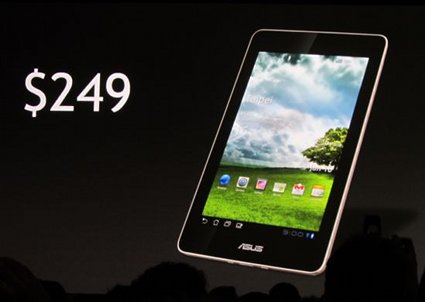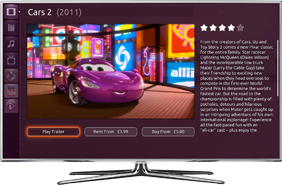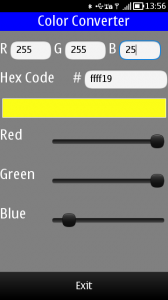Qualcomm named its Augmented Reality Platform “VuForia” at CES 2012. I was a bit confused reading the press release and thought it was a new product. Actually, it is the augmented reality platform whose Beta SDK has been released in December 2011. Qualcomm explains that “Vuforia’s computer vision functionality will recognize a variety of 2D and 3D visual targets. With support for iOS, Android, and Unity 3D, Vuforia will allow you to write a single native app that can reach over 400 models of smartphones and tablets.” To showcase the AR platform, Qualcomm and Sesame Workshop, the producer behind Sesame Street, have joined forces to explore augmented reality experiences for children and created a prototype playset that brings physical toys to life. Jean-Luc Aufranc (CNXSoft)Jean-Luc started CNX Software in 2010 as a part-time endeavor, before quitting his job as a software engineering manager, and starting to write daily news, and […]
Asus Unveils 249 USD Nvidia Tegra 3 Android 4.0 Tablet
During Asus Keynote at CES 2012, the company showed the Eee Pad MeMo 7 (ME370T) featuring a Nvidia Tegra 3 Quad-core processor running Android ICS with 1GB of RAM, 16GB to 32GB of storage, WiFi, Bluetooth, aGPS, a SIM card slot, micro-HDMI output and up to 8.5 hours of battery life. As you can see in the picture above, the good news is that the Tablet would be available for 249 USD in Q2 2012 according to reports in several websites. I could not find Asus official press release. In another blog, I found that Nvidia also announced DirectTouch technology that uses the Nvidia Tegra 3 companion core to sample touch on the device more frequently (about three times more often) resulting in a more responsive UI. Jean-Luc Aufranc (CNXSoft)Jean-Luc started CNX Software in 2010 as a part-time endeavor, before quitting his job as a software engineering manager, and starting […]
Ubuntu TV Features and Video Presentation
A few weeks ago, I wrote a post about Ubuntu Smartphone and Television UI Mockups, and today we know more as Ubuntu has just released more information on Ubuntu TV as well as a Video promo of the system. Here are the key features of Ubuntu TV : All broadcast television – Terrestrial broadcast in US and EU standard formats, for SD and HD content with EPG. Cable and satellite possibilities – Integrate your cable or satellite service into Ubuntu TV. Online Videos – Ubuntu TV integrates online content providers to offer a diverse catalogue of movies, TV shows and music straight from the Internet. Tablet/Smartphones Interaction – Link phones or tablets to Ubuntu TV, presenting related content to viewers while they watch such as information on movies by the same director or the reaction on Twitter during live shows. Intelligent search – To simplify and streamline the experience Ubuntu […]
Always Innovating Unveils Open Source Android 4.0 HDMI Dongle STB
Always Innovating announced the “HDMI Dongle”, an open source portable STB that runs Android 4.0 on a Texas Instruments OMAP4 processor clocked between 1 and 1.8GHz with 256MB to 1GB of RAM, a microSD slot, Wi-Fi, Bluetooth and a remote control that provides NFC & accelerometers. The HDMI Dongle is a device of the size of a USB stick that can be plugged into any HDMI port to transform a any HDMI (and USB) capable TV into a smart TV. The USB port is used to power the device. The company says the HDMI Dongle is “technically compatible with GoogleTV”, which probably means it is not yet supported, but a software upgrade could enable Google TV for Android 4.0. The device provides a full-compatible Android experience and any application for this operating system can run on the dongle. The HDMI Dongle can stream and decode from the Internet 1080p H.264 […]
Tizen Releases Source Code and SDK Previews
Tizen, a new Linux based HTML5 operating systems aimed at mobile and consumer devices, was announced at the end of September 2011 without much detail. Today, Tizen has posted a set of pre-release tools, source code and related documentation to give application developers an early look at Tizen. Tizen Alpha (pre-1.0) is a very early preview and is not yet designed for use to create production applications. They specifically released the following items: Tizen source code preview – Operating system source code, including middleware, basic UI, and menu interface Tizen SDK preview – SDK & APIs: Web IDE, Emulator, Web API documentation, and Toolchain If you plan to try Tizen SDK, you development machines should match or exceed the following requirements: Ubuntu 10.04/10.10/11.04 32-bit (Windows and Mac version will be available later) At least dual-core 2 GHz CPU (recommend VTx supported by CPU) At least 2 GB of RAM memory […]
Freescale Announces i.MX6 Lite Series
Last year, Freescale introduced i.MX6 series processors to the market in single, dual and quad core Cortex A9 configurations, today at CES 2012, they have announced i.MX6 Lite Series in single and dual core configuration respectively the i.MX6SoloLite and i.MX6 DualLite. Both processors incorporate ARM Cortex-A9 cores and E-Ink controllers and are especially suited to e-Readers, but Freescale expect the i.MX6 DualLite to also to be used in tablets, IPTVs, IP phones, medical patient monitoring systems and home energy management solutions. The new processors are software-compatible with other i.MX 6 series devices, so that developers can create end-product at different price points using a common platform. Freescale explains that “this scalability enables the rapid creation of complete end-product portfolios that can adjust and scale to meet evolving market demands and requirements”. The two new processors come to replace Freescale i.MX508 device, which is currently used in millions of eReaders. Here […]
Color Converter for Nokia Symbian Anna / Belle
I’ve developed a small Qt Quick application called ColorConv that can convert RGB color to HEX color used in HTML pages (e.g. 255,255,255 -> #FFFFFF) and vice versa mainly to play with Qt Creator QML and test Nokia Ovi Store application submission process. You can enter the Red, Green, Blue values manually by typing with the default numerical keypad in Symbian or use the slider to select the value. Alternatively you can enter the hexadecimal code to get the RGB value. If you are interested, you can download it in Ovi Store and in case you have some requests please comment on the support page. Nokia Ovi Store Submission Process Nokia submission process is almost free (1 Euro) and it took about 2 weeks to get my application published. I basically followed the instructions given on submit Qt applications to the Ovi Store PDF. The first thing you have to […]
HTC and Via Mobile Smartphones Powered by ST Ericsson Nova U8500
ST Ericsson is showcasing HTC and Via Mobile Android smartphones based on ST Ericsson Nova U8500 dual-core Cortex A9 processor at CES 2012. The two phones are the HTC Sensation (Z710t) and Via Mobile Smartphone (I could not find any names) targeted at the Chinese market, although they plan to sell them in Europe and US later. The Via Mobile phone features a 4.3″ capacitive touchscreen, HSPA+ (14.4Mbps) and a 5MP rear camera. The smartphones were apparently running gingerbread, but they will also release an Android ICS version soon, as the latest Android release is already running on their hardware reference platform. Performance wise, I’ve seen an Antutu Benchmark that gives HTC Sensation Z710t a score of 4729 that’s roughtly equivalent to LG Optimus 2X (Score: 4729) based on Nvidia Tegra 2. The price of the phones were not disclosed, but the ST Ericsson HTC Sensation is already sold in […]










